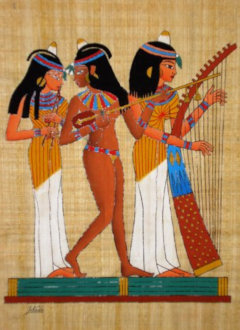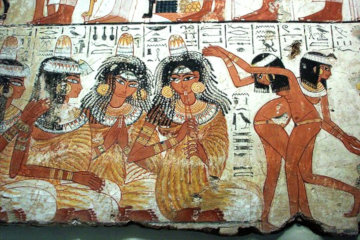Dead Party Girls

| |
| The papyrus picture of ancient Egyptian musicians I have on my wall. |
I have, hanging on my lounge room wall, a papyrus with a reproduction of an Egyptian fresco showing three female musicians, one playing a harp, one a lyre sort of thing, and one playing double pipes. Two of the musicians are wearing transparent linen dresses with fancy bead collars; the third is wearing the bead collar but her only other garment is extremely skimpy knickers - what I think is today called a "string bikini". All three, however, have fancy wigs on top of which are white cones. The white cones have rounded tops, on which are gold (or at least, yellow) decorations.
When I bought my papyrus from a shop in Luxor, it was a toss-up between the three musicians or the other famous one from the tomb of Nebamun showing a group of women in what look like gold lame dresses. One of them is playing the double pipes, the others are keeping time by clapping, while two girls, naked apart from their wigs and their string bikini bottoms, are dancing. Possibly because vigorous dancing would dislodge them, the dancers do not have these cones on their wigs, but all the other women do.

| |
| Naked go-go dancers always contribute to the party atmosphere - and ancient Egyptians were no different! |
Other scenes from Nebamun's tomb show a group of seated women offering each other lotus blossoms to smell, or seated women strumming on lyres. All, without exception, have these cones on top of their wigs. It would seem that in the 18th Dynasty at least, these cones were a necessary part of female attire - and not just at parties being entertained by near naked dancers. Another scene shows Nebamun hunting duck in the marshes and while he stands on a rather flimsy papyrus boat wielding his throwing-stick and grasping ducks by their feet, his wife stands on the back of the boat clutching a bunch of lotus flowers and with her cone firmly seated on her wig!
Curiously, although there are plenty of statues of women, I cannot recall a single one with a cone on her head. A possible reason is that statues were more formal depictions and the cones were only worn at parties or other occasions when you were enjoying yourself. Certainly none of the goddesses of ancient Egypt, whether in statues or paintings, were ever depicted with cones.
The wigs that the Egyptian women wore were usually made of human hair, but that could be supplemented with date palm fibre. The main thing I feel when looking at these creations is pity for the women who wore them, for they must have been horribly hot in a counry that is already hot to begin with! The reason for wearing them is simple, however. Egyptians were scrupulous about cleanness; priests shaved the whole of their bodies lest they either sweat unduly or harbour fleas or lice (which was the point of the third plague; at one stroke God, through Moses, rendered every priest in Egypt unclean and unable to fulfil his sacerdotal functions!)
It would seem that Egyptian women common shaved their heads to get rid of fleas, lice or other vermin. However they were canny enough to realise that a bald woman lacks sex appeal, hence the wigs, which could be washed more vigorously - perhaps in hotter water - than hair on the head can be!
So what were these cones? The usual theory, put forward by S. Chaudhri in the "South Asian Journal of Pharmaceutics" in 2009 is that they were perfumed fat, which would be gradually melted by the wearer's body heat - see the above about wearing hot wigs! - and so keep a constant pleasant smell. Chaudhri also suggested that the perfumed fat might "condition the hair", which seems unlikely. Or, even if it did, it is even more unlikely that any woman would worry about the condition of her date palm fibre! Others have suggested that the grease running down the wig and onto the woman's back might act as a form of sunscreen, though it is not clear how many parties were held out in the hot sun. Egyptians, so far as I know, did not do BBQs or indulge in surfing.
Such fanciful ideas appear now to have been laid to rest. Australian archaeologists from Monash University under the direction of Dr Anna Stevens, working at Tel el-Amarna, the city built by the heretic pharaoh Akhenaton, have uncovered two graves, an intact one in 2010 and a second in 2015 that had already been looted by tomb robbers. The first was the grave of a young woman of about 20; the sex of the second could not be determined, due to the depredations of the tomb robbers.
Both bodies had the remains of cream-coloured cones on the top of their heads. The cones were hollow, about three inches tall and four inches thick, but they were made of wax. Even beeswax does not melt at body temperature, nor at the temperatures to be found in Egypt - melted hives are no good to bees! Even worse, "We couldn't detect any trace of perfume in these cones," said Dr Stevens. "But that doesn’t indicate that perfume wasn't once present in these cones or others."
Of course it is possible that the cones worn by Egyptians in their daily lives were different from the cones they wore in death. Grieving relatives might be annoyed to find that the cone for which they had paid good money had melted by the time of the funeral and was now a puddle of grease in the bottom of the coffin! Alternatively, the archaeologists note that both burials were of ordinary people, not the upper classes whose portraits have come down to us. It is possible that the cones found in the tombs were a crude attempt to ape their betters - perfume was expensive - in death, if not in life?
What amuses me, however, is the archaeologists solemnly proclaiming that these cones were worn as part of a purification ritual. Quite why archaeologists have this "thing" about rituals I do not know; if they find anything whose purpose is not immediately apparent, it is promptly stuck on display with the label "ritual object" or "cultic object" attached. As you are possibly aware, naked go-go dancers do not feature in the service of High Mass, nor in Buddhist rituals, Muslim mosques, Confucionist shrines - and even in Hindu temples, where ritual prostitution does take place, the dancing girls are fully clothed while performing before the gods. There is no evidence that ancient Egyptian religion was any different!
If, as the archaeologists argue, perfume was used to cleanse and purify - an allegation for which I know of no evidence - even the dumbest of ancient Egyptians would rub it on his or her body. Nobody, but nobody, has ever seen the need to ritually cleanse and purify a wig, whether or not it includes date palm fibre!
No, the cones were worn at parties - pretty wild parties too, if Nebamun's "Facebook" frescoes are to be believed!
The question is, why were they worn? As Pliny remarks in his description of the perfumes available to the cultured Roman:
"Perfumes serve the purpose of the most superfluous of all forms of luxury; for pearls and jewels do nevertheless pass to the wearer's heir and clothes last for some time, but unguents lose their scent at once and die in the very hour when they are used. Their highest recommendation is that when a woman passes by her scent may attract the attention even of persons occupied in something else - and their cost is more than 400 denarii per pound! All that money is paid for a pleasure enjoyed by somebody else, for a person carrying scent about him does not smell it himself!"
Pliny, Natural History XIII:iv
The phenomenon on which Pliny remarks is known as "olfactory fatigue". This is what makes it possible for sewage farm workers and mortuary employees to carry on their tasks, for after a few minutes the nose ceases to notice the ambient smells, whether pleasant or otherwise. A visitor walking into an ancient Egyptian party may have had his sense of smell assaulted by all that perfume, but the ladies themselves would have been completely unaware of it.
What they would have been aware of was that their perfume cone cost more than a year's salary for a poor peasant and that her neighbour's cone was slightly smaller - happiness - or slightly larger - discontent and envy - than hers. Which perhaps brings us to the real reason why the buried cones were made of painted wax.
If you ever have to deal with an undertaker, one of the first things you will be asked is to choose the coffin - "casket" in undertaker speak. You will be offered a choice of oak, beech, ash or pine, with pine being the cheapest and oak the most expensive. What you will not be told is that the coffins are all the same - chipboard or MDF with a layer of plastic veneer over the top. If you want to be shocked, ask whether they do a solid oak coffin? The price you will be quoted will make your eyes water!
The same sort of duplicity is on tap for the coffin handles, which are normally of plastic, anodised with a variety of metallic finishes - which makes sense, particularly if your loved one is being cremated. My understanding is that solid metal handles are removed before the coffin is placed in the furnace - after all, the last thing you want to find as you reverently tip your loved ones' ashes into the ground or over the side of the boat or out of an aeroplane is the gleam of nodules of molten metal!
The ancient Egyptians may have paid to have their dear departed sent into the underworld ready to party with her perfume cone on her head, but the thrifty undertakers saw no point in wasting the equivalent of 400 denarii. They made a wax substitute, confident that no one was going to poke it with their fingers and discover the deception.
No one, that is, until Anna Stevens came along and exposed the fraud - but it's all right. The grieving relatives are not around to sue and the undertakers too have passed into great Beyond - but I wonder what they said as their hearts were weighed against the Feather of Truth in the judgement hall of Osiris, with the Devourer of Souls waiting hungrily behind the scales?
===========
label "ritual object" My favourite such tale is of a pottery tube found at Kahun by Sir Flinders Petrie and deposited in the Manchester University Museum, where, of course, it was labelled as "ritual object". Some years later a local apiarist who was knowledgeable about the history of his craft happened to visit the museum and was affronted by the label. He sought out one of the curators and said words to the effect, "That ain't no ritual object, that's a bee hive!" It is to the credit of the curator that he took the man seriously, investigated further and discovered a tiny limp of beeswax stuck inside the tube - and, to make the thing absolutely certain, there was a bee's leg stuck in the wax! Return
© Kendall K. Down 2019





